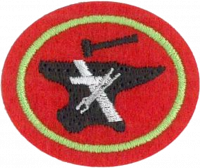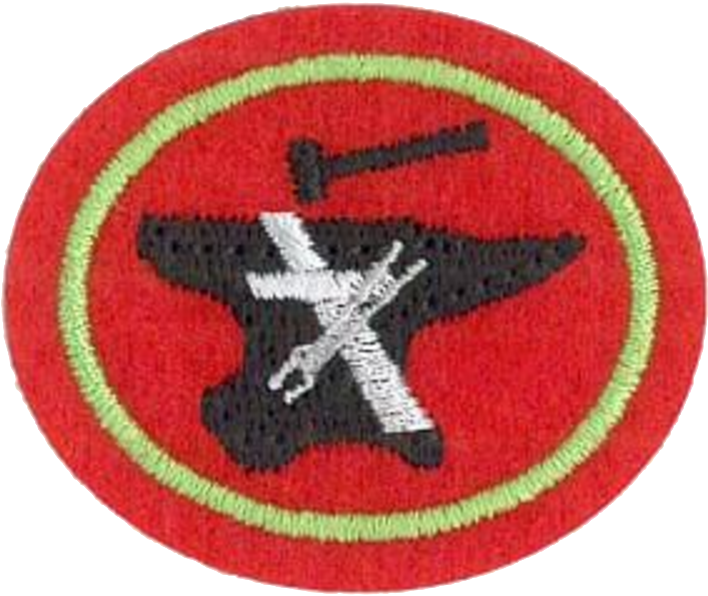Difference between revisions of "AY Honors/Blacksmithing/Requirements/es"
(Created page with "</noinclude>Encender <noinclude>") |
|||
| Line 139: | Line 139: | ||
<noinclude></noinclude><section end=req9 /></b> | <noinclude></noinclude><section end=req9 /></b> | ||
| − | <b>10. <section begin=req10 /><noinclude> | + | <b>10. <section begin=req10 /><noinclude></noinclude>Con su instructor, discutir y repasar los tipos básicos de tenazas disponibles en la herrería. Las tenazas se clasifican por la forma (o descripción) de la mandíbula, que afecta su uso. Algunos tipos básicos son: plana, de cuernos o colmillos, tubular, mordida V, dentadas, nariz redonda, boca de lobo |
| − | </noinclude>Con su instructor, discutir y repasar los tipos básicos de tenazas disponibles en la herrería. Las tenazas se clasifican por la forma (o descripción) de la mandíbula, que afecta su uso. Algunos tipos básicos son: plana, de cuernos o colmillos, tubular, mordida V, dentadas, nariz redonda, boca de lobo | + | <noinclude></noinclude><section end=req10 /></b> |
| − | <noinclude | ||
| − | |||
<b>11. <section begin=req11 /><noinclude></noinclude>Discutir cómo correctamente iniciar y apagar un fuego en la fragua. | <b>11. <section begin=req11 /><noinclude></noinclude>Discutir cómo correctamente iniciar y apagar un fuego en la fragua. | ||
| Line 154: | Line 152: | ||
::<b>ii. <section begin=req11aii /><noinclude></noinclude>Apagar | ::<b>ii. <section begin=req11aii /><noinclude></noinclude>Apagar | ||
| − | <noinclude></noinclude><section end=req11aii /></b> | + | <noinclude>'-</noinclude><section end=req11aii /></b> |
| − | :<b>b. <section begin=req11b /><noinclude> | + | :<b>b. <section begin=req11b /><noinclude></noinclude>Gas |
| − | </noinclude>Gas | + | <noinclude></noinclude><section end=req11b /></b> |
| − | <noinclude | ||
| − | |||
| − | ::<b>i. <section begin=req11bi /><noinclude> | + | ::<b>i. <section begin=req11bi /><noinclude></noinclude>Encender |
| − | </noinclude> | + | <noinclude></noinclude><section end=req11bi /></b> |
| − | <noinclude | ||
| − | |||
| − | ::<b>ii. <section begin=req11bii /><noinclude> | + | ::<b>ii. <section begin=req11bii /><noinclude></noinclude>Apagar |
| − | </noinclude> | + | <noinclude></noinclude><section end=req11bii /></b> |
| − | <noinclude | ||
| − | |||
<b>12. <section begin=req12 /><noinclude><div lang="en" dir="ltr" class="mw-content-ltr"> | <b>12. <section begin=req12 /><noinclude><div lang="en" dir="ltr" class="mw-content-ltr"> | ||
Revision as of 19:54, 16 May 2021
Nivel de destreza
2
Año
2015
Version
28.11.2025
Autoridad de aprobación
División Norteamericana
1. Definir herrero y la herrería.
2. Aunque tanto la forja y fabricación pueden ser una parte de la herrería, sus proyectos pueden o no incluir la fabricación. Discutir con su instructor de las diferencias básicas entre la forja y la fabricación y ser capaz de explicar las diferencias.
3. Discutir con su instructor acerca de las reglas de seguridad para la herrería. Asegurarse de entender por qué son importantes y explicarlas o demostrarlas cuando se le pregunte.
4. Mientras discute con su instructor el proceso del tratamiento de metales, desarrollar una comprensión básica de los principios de endurecer y templar metales.
5. Identificar y explicar los nueve elementos básicos requeridos para la herrería.
- a. Fragua
- b. Combustible
- c. Soplador (fuelle) y conductos de ventilación
- d. Yunque
- e. Martillo
- f. Tenazas
- g. Tornillo de banco
- h. Gafas protectoras
- i. Tapones para los oídos
6. Identificar las partes de un yunque de patrón de Londres e identificar sus usos:
- a. Cepo (y base)
- b. Cuerno cónico o bigornia
- c. Grada
- d. La cara
- e. Ojo cuadrado
- f. Ojo redondo
7. Explicar las dos clases básicas de fraguas (combustible sólido y gas) y demostrar capacidad de identificar las partes de la cual usará.
- a. Fragua de combustible sólido
- i. Fuelle
- ii. Olla de fuego
- iii. Tuyere
- iv. Basurero de ceniza
- v. Rompedor de clínker/escoria
- vi. Placa de tuyere
- b. Fragua de gas
- i. Fragua
- ii. Manguera
- iii. Manómetro
- iv. Regulador
- v. Quemador
8. Identificar las partes básicas de un martillo y una lista de las clases básicas de martillos usados en la herrería. (La forma de un martillo refleja la tarea que está diseñado para completar).
- a. Partes de un martillo
- i. Mango
- ii. Cabeza
1. Cara
2. Peña
- ii. Cabeza
- b. Tipos de martillos de herrería
- i. Peña cruzada
- ii. Peña angulada
- iii. Peña recta
- iv. Peña de bola
9. Discutir el utillaje con su instructor y explicar cómo se utiliza. Aunque muchos tipos de utillaje tienen mangos, ¿cómo es el utillaje diferente de un martillo?
10. Con su instructor, discutir y repasar los tipos básicos de tenazas disponibles en la herrería. Las tenazas se clasifican por la forma (o descripción) de la mandíbula, que afecta su uso. Algunos tipos básicos son: plana, de cuernos o colmillos, tubular, mordida V, dentadas, nariz redonda, boca de lobo
11. Discutir cómo correctamente iniciar y apagar un fuego en la fragua.
- a. Combustible sólido
- i. Encender
- ii. Apagar
'-
- b. Gas
- i. Encender
- ii. Apagar
12.
Discuss how to PROPERLY clean and maintain the blacksmithing equipment you are using.
- a.
Forge
- b.
Anvil
- c.
Hammers
- d.
Tongs
13.
While each hammer, tong, and tool serves a specific function there are only a few foundational skills of a blacksmith. Discuss with your instructor the three to five skills they feel are most important for their style of blacksmithing.
- a.
Drawing
- b.
Tapering
- c.
Upsetting
- d.
Spreading
- e.
Twisting
- f.
Bending
- g.
Drifting (or Punching)
- h.
Slitting (or Splitting)
14.
With supervision make two projects. You will be using low carbon steel at least ¼ inch thick and utilizing techniques your instructor will teach you. These projects need to include the following techniques:
- a.
Draw out the end of a square piece by forging a round taper, and placing a finial (Curly queue) on the end.
- b.
Use the horn of the anvil to forge a U-shaped bend.
- c.
Form a decorative twist in a piece of square steel.
15.
Choose one of the following:
- a.
Prepare a worship talk discussing blacksmithing from the Bible and/or the spirit of prophecy and discuss its application to our lives.
- b.
Write a 250 plus word paper about metal processing or blacksmithing from the Bible and/or the spirit of prophecy and its application to today.
- c.
Using your artistic ability, draw, create, make a short video etc., using blacksmithing from the Bible and/or the Spirit of Prophecy to illustrate a spiritual lesson and present to your pathfinder group.
16.
Blacksmithing and metal working are ancient arts. When where they first mentioned in the Bible? What kind of things were made?
17.
There are many references to “smiths” in the Bible. What is the significance of the blacksmith in the following texts:
- a.
- b.
- c.


